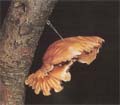|
|
|
Scientific name
Atrophaneura horishana (Matsumura, 1910) |
|
Chinese name 曙鳳蝶、桃紅鳳蝶
|
|
English name
Aurora Swallowtail, Highland Red-bellied Swallowtail |
|
Classification 鳳蝶科(Papilionidae),鳳蝶亞科(Papilioninae),裳鳳蝶族(Troidini)
|
|
Diagnosis
Large-sized swallowtail butterfly. Wingspan 12-18 cm,
female much larger than male. Wing shape similar between
both sexes but broader in female; colouration sexually
dimorphic. Head black with red hairs and scales; thorax
and abdomen black dorsally and ventrally but with black
dots in rows along lateral sides of abdomen. Forewing
broad with termen straight; ground colour blackish gray
and slightly metallic blue, while in female each vein
tinged whitish gray scales along both sides. Hindwing
broad with termen undulate; upperside in male unicoloured
but spotted in female; undersides of both sexes having
two rows of large black spots arranging on m1, m2, m3
and cu1 cells, with red background in male and auroral
background in female; inner margin of both sexes bearing
prominent androconial hairs. Immature stages somewhat
similar to Byasa polyeuctes termessus (Fruhstorfer) (Figs.
179-180) but much larger in size and lighter in colouration. |
|
Distribution
This species is endemic to Taiwan and has no similar species
around the surrounding areas. It is in general active
at about 1000-2500 m in elevation and only abundant in
primary forests, especially the Taroko National Park,
Shei-pa National Park and Yushan National Park. The distributional
boundary in southern Taiwan could be Lukuei area (Hamano,
1987). |
|
Habitat and Ecology
The first brood of adult starts to emerge in the early
summer. Adults are often seen visiting flowers of Sambucus
formosana Nakai, Lonicera acuminata Wall (Caprifoliaceae),
Hydrangea aspera D.Don (Saxifragaceae), Euodia meliaefolia
(Hance) Benth. (Rutaceae), Eupatorium formosanum Hayata
(Compositae) (Yang & Lai, 2000), Styx spp. (Styracaceae)
and Verbenaceae in large schools. The larvae have been
reported feeding on Aristolochia heterophylla Hemsl.,
A. kaempferi Willd. and A. zollingeriana Mq. (Yang, 1997,
1998, Yang & Lai, 2000). This species may probably
be univoltine with very long occurring period from July
to December (Yang & Lai, 2000). The eggs are yellow,
spherical, covered by female secretions and laid under
the leaves of hostplants (Hsu et al., 1986; Lin, 1994;
Hsu, 1999). The larvae have prominent verrucae on their
body, which the ground colour is whitish black and with
two pairs of white bands on the third and fourth abdominal
segments. The hibernating states could be larval stages
(Hsu, 1986), adult or egg (Yang & Lai, 2000). Pupation
usually occurs in spring. |
|
Threats and Conservation Status
This species is still fairly common in some areas, but
may be threatened by commercial collecting by local and
alien collectors in accompany with rapid destruction of
habitats by overuse of herbicides and road construction
in highland of Taiwan. For more information about conservation
of this species see Yang (1997, 1998) and Yang & Lai
(2000). |
|
Remarks
|
|
 |
|
|

Atrophaneura horishana (Matsumura), female, Lishan |

Atrophaneura horishana (Matsumura), egg, Meifeng |

Atrophaneura horishana (Matsumura), 1st instar larva,
Meifeng |

Atrophaneura horishana (Matsumura), final instar egg,
Songgang |

Atrophaneura horishana (Matsumura), pupa, lateral view,
Songgang |

Atrophaneura horishana (Matsumura), pupa, dorsal view,
Songgang |

Byasa polyeuctes termessus (Fruhstorfer), 2nd instar larva,
Chudong |

Byasa polyeuctes termessus (Fruhstorfer), 4th instar larva,
Chudong |
|
|
|